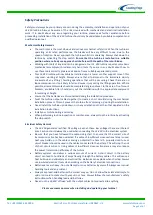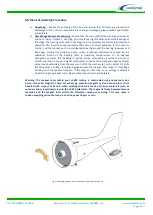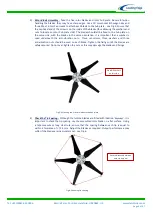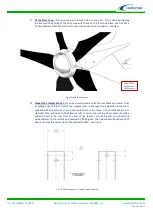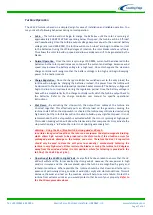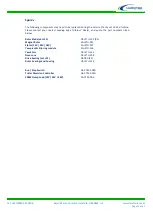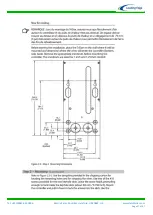
Tel: +44 (0)845 652 0396
Skyrrid Farm, Pontrilas, Hereford. HR2 0BW. UK
www.leturbines.com
Page 13 of 47
Electrical Installation
Please refer to Figs 12 - 14 for appropriate generic wiring diagrams. In a battery charging renewable
energy system there may be different ways of wiring small wind turbines, photovoltaic panels,
charge controllers and batteries together. This type of system will often expand ‘organically’, but
the following guidelines should be followed:
Follow the appropriate electrical code - The electrical wiring of your LE-450 turbine and
associated electrical systems must be done in accordance with national and local electrical
codes and regulations.
Do not connect the turbine or batteries during the installation - Ensure that the turbine is
not running or connected to the batteries during the installation or wiring process.
Connect the output cables of the turbine together to prevent the rotor from starting up.
Galvanic corrosion of electrical joints - Try to avoid connections between dissimilar
metals. For example, connecting copper and aluminium together will result in galvanic
corrosion of the connection. This will increase the electrical resistance of the connection
(wasting energy), and reduce the mechanical integrity of the joint. Where possible, use a
fluxed solder to make electrical joints.
Protect the cables - The power transmission cables must be protected from mechanical
damage and fatigue. Run the cables through an approved conduit / trunking.
Cable strain relief - Prevent mechanical strain on the transmission cables running down
the tower from the turbine. Clip the cables to the inside of the tower. Failure to do this will
result in excessive mechanical strain on the cable joints within the slip-ring assembly and
may cause a failure. Cable ties or cable glands are a good way to prevent mechanical strain
on the cables.
‘Earth’ the system - The turbine tower should have its own separate earth point. The
negative terminal of the battery bank should also be earthed. This provides protection
against the build-up of static and lightning strikes. The tower should be earthed separately
with its own ground rod if there is a long transmission distance between the tower and
batteries. An appropriate surge arrestor could also be used to help prevent damage to the
battery charging system during a lightning strike. Ensure that the earth cables are of the
same rating as the positive and negative cables.
Cable Selection - The cable size table should be used to select the minimum sized cable for
a given transmission distance. Voltage drop in the cable will be improved if a larger cable is
used. We recommend using ‘Tri-Rated’ cable as it should comply with the wiring codes for
your area.
Fuses - The turbine and charging circuit should be protected with a suitably rated
‘slow-blow’ DC fuse or DC circuit breaker. Please refer to the table below for the minimum
fuse rating. Because a wind turbine is very unlikely to produce a current surge an in-line
fuse is only really protecting against short circuit. The fuse or breaker should be
positioned between the turbine and batteries (on the positive cable). If a stop switch is
used (recommended) the fuse should be positioned between the switch and the batteries.
LE-450 Nominal
Output Voltage
DC Fuse / DC Circuit Breaker Rating
12V
50 Amp
24V
30 Amp
48V
15 Amp
Summary of Contents for GA-LETU-016
Page 47: ......





